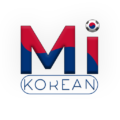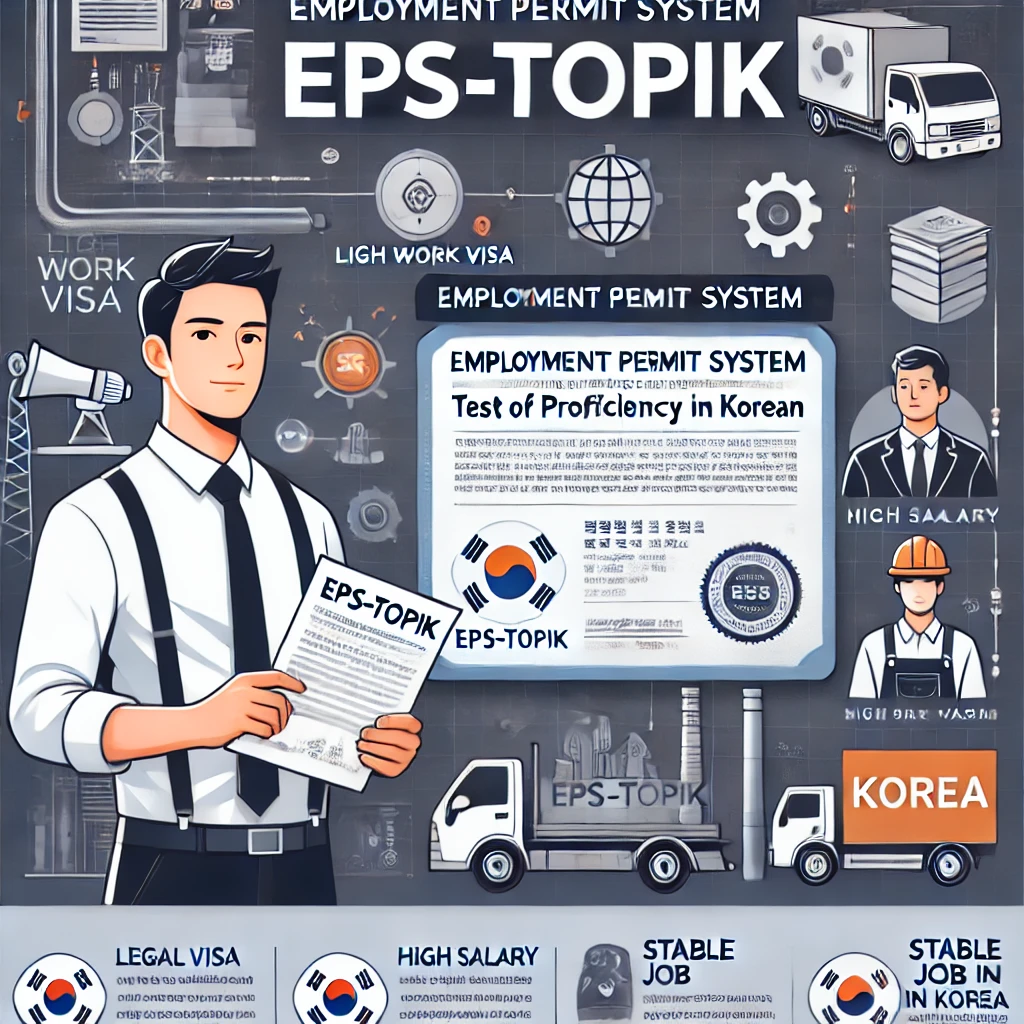EPS-TOPIK
Employment Permit System - Test of Proficiency in Korean
Benefits of EPS-TOPIK
🌍 Gateway to Employment in South Korea – Secure a job in manufacturing, construction, agriculture, and more!
💰 Earn Competitive Salaries – Get higher wages and better benefits than in many other countries.
🛂 Legal Work Visa (E-9) – Work legally in Korea with job security and government support.
📈 High Demand for Skilled Workers – Korean industries actively seek EPS-TOPIK certified workers.
🗣 Practical Korean Language Skills – Learn essential Korean for workplace communication.
🏡 Opportunity for Long-Term Employment – Increase chances of contract renewal and stable career growth.
🌏 Cultural & Workplace Adaptation – Get familiar with Korean work ethics and daily life.
🚀 Pass EPS-TOPIK & Start Your Career in Korea! 🇰🇷
- Introduction to the Korean Language
- What is the Korean language?
- Korean (한국어, Hangugeo) is the official language of South Korea and North Korea. It’s spoken by over 77 million people worldwide.
- It’s considered a language isolate, meaning it doesn't belong to any specific language family.
- Historical background:
- Korean has a long history with roots going back over a thousand years, evolving from Classical Korean (Middle Korean) to Modern Korean.
- The Korean Alphabet – Hangul (한글)
- Hangul Overview:
- Hangul is the Korean writing system, created in the 15th century by King Sejong the Great. It was designed to be easy to learn and use, compared to the complex Classical Chinese characters used before.
- Structure of Hangul:
- Consonants: There are 14 basic consonants and 5 double consonants.
- Vowels: There are 10 basic vowels, which are formed using three simple lines representing the sky, earth, and humanity.
- How Hangul works:
- Hangul characters are grouped into blocks that each represent a syllable. Each block typically consists of 2 to 3 characters (one consonant and one vowel, or a consonant-vowel-consonant structure).
- Example of Hangul:
- The word "Korean" in Hangul: 한국어 (Han-guk-eo)
Cultural Aspects of the Language
- Language and Respect:
- Korean places a big emphasis on respect and formality. The language reflects different levels of respect depending on age, social status, and familiarity.
Fun Facts about the Korean Language
- Hangul is often considered one of the easiest writing systems to learn because of its logical structure.
- There are no spaces in older Korean texts, and spacing was introduced in the 20th century.
- Many loanwords in Korean come from English, especially in modern culture.
- Conclusion
- Encourage your readers to continue exploring the language, practicing daily, and using resources to improve their skills. Learning Korean opens up doors to understand Korean culture, history, and entertainment!
1. What is EPS-TOPIK?
- EPS-TOPIK stands for Employment Permit System - Test of Proficiency in Korean. It’s a language proficiency test designed to evaluate the Korean language skills of foreign workers who wish to apply for employment in South Korea through the EPS (Employment Permit System).
- The test is administered by the Human Resources Development Service of Korea (HRD Korea).
2. Purpose of EPS-TOPIK
- The primary purpose of this test is to assess the basic Korean language skills of foreign workers to ensure they can communicate effectively in the workplace. This is essential for safety, job performance, and overall integration into Korean society.
- The test helps employers in South Korea to select workers who have the necessary language proficiency to succeed in a Korean work environment.
3. Eligibility for EPS-TOPIK
- Foreign workers from specific countries: The EPS-TOPIK is primarily aimed at people from countries that have agreements with South Korea regarding the employment of foreign workers, such as Vietnam, Indonesia, Philippines, Nepal, Sri Lanka, Bangladesh, Pakistan, and several others.
- Age Limit: Applicants must be between the ages of 18 and 39 (this can vary slightly depending on the country).
- Previous EPS-TOPIK Results: Individuals who have previously passed the test can reapply if they wish to improve their scores or renew their eligibility.
4. Structure of EPS-TOPIK
- Listening: This section tests your ability to understand spoken Korean. You will listen to short dialogues or passages and answer related questions.
- Reading: The reading section tests your ability to understand written Korean texts, including passages, sentences, and questions about everyday work-related topics.
- The written test is typically 40-50 minutes long, with questions focused on basic Korean vocabulary, grammar, and practical language used in daily work scenarios.
5. Levels of EPS-TOPIK
- Level 1: Basic understanding of Korean. This level indicates that the applicant can understand simple Korean phrases and expressions used in daily life or at work.
- Level 2: Higher level of proficiency, indicating the applicant can understand more complex expressions and handle some work-related tasks in Korean.
- Pass Criteria: Generally, a Level 2 or above is required to be eligible to work in South Korea through the EPS system, though it may vary by country and sector.
6. How to Apply for EPS-TOPIK
- Application Process:
- Check if your country is participating in the EPS program.
- Follow your country's specific procedures for applying, which typically involves registering online or at designated centers.
- Pay any applicable application fees.
- After registration, you will receive information on the test date, venue, and any necessary documents.
- Test Fee: The test fee varies by country but is generally low compared to other proficiency tests.
7. Test Locations
- EPS-TOPIK is administered at test centers in the participating countries. In most cases, these are designated government-run centers or official EPS partner organizations.
- The test may only be available in select major cities in each country.
8. Study Materials and Preparation
- Official Materials:
- EPS-TOPIK Prep Books: There are official books and study guides published by the HRD Korea and other local publishers. These books typically include practice tests, listening exercises, and tips for both the written and oral sections.
- Online Resources: Websites like EPS-KOREA, Talk To Me In Korean, and KoreanClass101 provide free and paid resources for EPS-TOPIK preparation.
- Key Focus Areas:
- Vocabulary and Grammar: Focus on basic vocabulary used in everyday work situations (e.g., greetings, asking for help, numbers, directions, work tools).
- Listening Practice: Listening to common phrases, instructions, and announcements in Korean.
- Pronunciation Practice: It’s crucial for the oral section, so practicing basic sentences and responses in Korean will help a lot.
9. Test Results
- Test results are typically available a few weeks after the test date. Applicants will receive their scores and a certificate indicating their level.
- If you pass, you can proceed with the next steps of applying for a work visa in South Korea.
10. After EPS-TOPIK: Work in South Korea
- EPS System: If you pass the EPS-TOPIK and meet other criteria (such as health checks and background checks), you can apply for the E-9 visa (Employment visa for foreign workers).
- Job Placement: Once you pass the EPS-TOPIK, you will be eligible for job placements in South Korea under the EPS system. Jobs typically include positions in agriculture, manufacturing, construction, and service sectors.
11. Additional Tips for Success
- Practice Regularly: Set aside time each day to practice listening, speaking, reading, and writing in Korean. This will not only help you with the test but also prepare you for life in South Korea.
- Focus on Basic Work-Related Vocabulary: Study common phrases and expressions that might come up in a Korean work environment.
- Take Mock Tests: Simulate the test environment by taking mock tests to familiarize yourself with the format and timing.
The TOPIK (Test of Proficiency in Korean) is a standardized language proficiency test designed to assess the Korean language skills of non-native speakers. It is widely used for academic, professional, and immigration purposes, particularly for those planning to study or work in Korea.
TOPIK Test Levels
The test is divided into two main levels:
- TOPIK I (Beginner level)
- TOPIK II (Intermediate to Advanced level)
Each of these levels is further broken down into a scoring system that corresponds to a range of proficiency levels.

